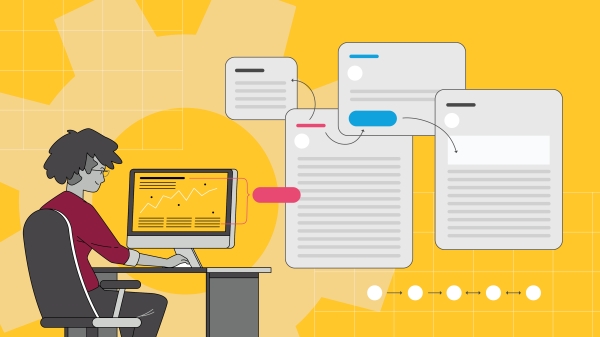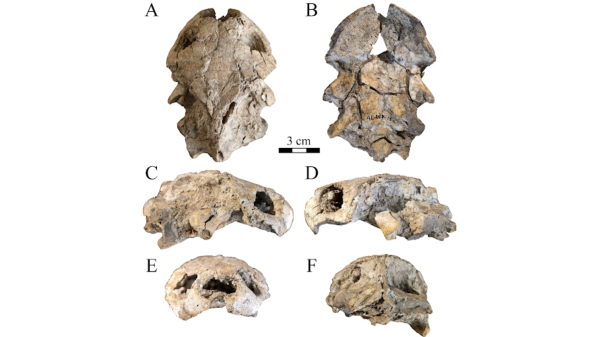Past meets future: Humanities students engage with WWI history through virtual reality

Editor’s note: This story is featured in the 2022 year in review.
“Welcome to the front line of the war.”
Looking around, students in Victoria Thompson’s HST 130 course, The Historian’s Craft, found themselves in No Man’s Land: the treacherous, muddy tract besieged by shelling that separated the Allied and German trenches during World War I.
“Put yourselves in the mindset of a soldier who has just arrived. Think about your motivation for joining up. What do you think about what you see around you?”
To help students prepare for an essay assignment based on letters by WWI German soldiers, Thompson arranged to immerse her class in the soldiers’ world. Through the use of Oculus Quest virtual reality (VR) headsets and hand-held controllers, the students had the unique opportunity to engage with WWI history in a simulated environment.
Thompson’s course was the first application of VR technology in a humanities course at Arizona State University and an inaugural in-class test of Huddle, a new instructional tool developed by an ASU student-led, student-run team at Learning Futures. With Huddle, 5G and cloud infrastructure enables groups of up to 13 students at one time to share the virtual space. Students are guided through an instructor-led experience, interacting with one another and 3D objects in a virtual setting.
As her students sat around tables in ASU’s Creative Commons, Thompson guided them through the lesson using a fact-filled narrative script, prompting deeper investigation and personal inquiry as they explored WWI terrain, examined a German uniform and studied a variety of artifacts, including weapons and artillery.
“I asked them questions about the objects and how the objects helped them understand the experience of the soldiers on the front lines,” said Thompson.
The students responded verbally during the lesson and later incorporated their perceptions and the connections made during the experience into their essays.
“Being able to get a more in-person look at certain objects can help understand what people back then might've been feeling or what they had to go through,” said Nathan LeFort, a history secondary education student enrolled in the course.
LeFort expounds on the benefit of re-creating a time period or subject and encouraging a student to virtually step into the shoes of someone from another era or culture, saying, “Especially for someone who is so into history, being able to get an up-close view on what you'd never get to before is, in my opinion, invaluable as an experience,” adding, “I think it could definitely be put to more use in other humanities classes in the future.”
The interactive experiences made possible by Huddle visualization tools provide opportunities for students in any field of study to connect with objects and activities that would not otherwise be possible in traditional settings.
“What’s most exciting to me is the accessibility it can afford, placing people within very specific contexts that they might not have been able to visit due to financial barriers, geographic barriers or other kinds of social or economic barriers,” said Olivia Hernández, creative manager at the Learning Futures Emporium.
“When we enter a museum, there's this sort of precious scarcity mindset where you can't get too close, and you can't touch anything,” but Huddle — operating in line with ASU’s charter — is “defined by whom we include, not by whom we exclude.”
This is emphasized by Thompson, who explains that seeing and virtually handling artifacts placed in context by an instructor evokes a strong emotional reaction, giving students a window into what people in the past may have felt or thought as they experienced something like going to war.
“It is possible to use other sources, such as written accounts, photographs or films, to develop this sense of ‘historical empathy’ — an ability to relate on a personal level with people in the past — but the VR experience seemed to accomplish this in a very different and memorable way.”
The Historian’s Craft course introduces students to the ways historians ask questions and propose answers, but the possibilities for using Huddle technology in other humanities classes abound.
Toby Kidd, director of Learning Futures Studios, says, “For something like the humanities, you’re dealing with a discipline that’s focused on the storytelling of lived experiences,” which Huddle is ideally situated to complement.
“We don't just want to put tech in the hands of instructors and students for the sake of doing it; this is intended to reinforce learning, to be tied to learning outcomes, so the pedagogy can shine through,” Kidd said.
To this end, all of the guild and project teams at Learning Futures are academically diverse student groups.
“It's important that students are the creators of these experiences because they are the workforce of tomorrow, they are in classrooms right now and they can see how they would benefit from having this in their current experience,” Kidd said.
Amanda Federico, the student project manager for the team, praised the student involvement in the instructional tool.
“Huddle's success is almost entirely due to the involvement of students because we're the ones who built it,” said Federico, who is double-majoring in animation and digital culture (media processing) and directs Barren Mind Improv, ASU’s student improv comedy troupe. “I love showing the magic of Huddle to all kinds of students!”
Thanks to the Huddle team working their “magic,” Thompson said her students “had a great time. They were extremely engaged and really understood what I wanted them to get out of the lesson.”
Instructors interested in integrating Huddle into their course should contact Learning Futures to begin the conversation.
Top photo: Humanities students engage with WWI history through virtual reality. Photo by Erica May/ASU
More Science and technology

When facts aren’t enough
In the age of viral headlines and endless scrolling, misinformation travels faster than the truth. Even careful readers can be swayed by stories that sound factual but twist logic in subtle ways that…

Scientists discover new turtle that lived alongside 'Lucy' species
Shell pieces and a rare skull of a 3-million-year-old freshwater turtle are providing scientists at Arizona State University with new insight into what the environment was like when Australopithecus…

ASU named one of the world’s top universities for interdisciplinary science
Arizona State University has an ambitious goal: to become the world’s leading global center for interdisciplinary research, discovery and development by 2030.This week, the university moved…